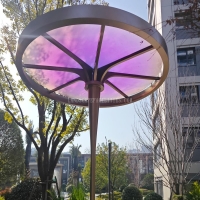Welcome to the website for landscape facilities products and knowledge.
How does the table’s design ensure it remains stable when used on uneven or sloped ground?
Outdoor tables face the constant challenge of maintaining stability on unpredictable surfaces. Modern engineering solutions address this through several innovative approaches that ensure reliable performance even on sloped or uneven ground.
The foundation of stability begins with adjustable leg systems. Many premium outdoor tables feature independently adjustable legs with precision mechanisms that can extend or retract to compensate for ground irregularities. This allows users to customize each leg's height, creating a level surface regardless of terrain variations. Some designs incorporate threaded feet that screw up or down, while others use push-button adjustment systems for quick modifications.
Weight distribution plays an equally crucial role in table stability. Engineers calculate optimal center of gravity placement, often positioning heavier components toward the table's base. This lower center of mass prevents tipping and rocking motions. Some designs incorporate weighted bases or strategically placed support crossbars that increase the table's resistance to overturning, particularly important when placed on inclines.
Material selection contributes significantly to stable performance. Tables designed for rugged outdoor use often feature heavier gauge materials in their bases while maintaining lighter weight tops. This careful balance between structural heft and practical portability ensures the table remains grounded without becoming immobile. The strategic use of materials like powder-coated steel for bases with aluminum or composite tops creates this ideal weight relationship.
Advanced designs incorporate self-leveling mechanisms that automatically compensate for slope variations. These systems use pendulum-based or fluid-filled leveling devices that shift counterweights or adjust support points in response to ground angle changes. While more complex, these mechanisms provide exceptional stability without requiring manual adjustments from users.
The geometry of table legs and support structures undergoes rigorous testing. Wider stance designs with legs angled outward from the center provide greater stability than vertical leg configurations. This pyramidal structure creates a larger footprint that resists rocking motions. Additionally, many tables feature cross-bracing between legs that creates triangular support patterns, one of the most stable geometric configurations in engineering.
Ground interface components represent another critical stability element. Specially designed feet with increased surface area distribute weight more effectively across soft ground. Some feature spiked ends for penetration into turf, while others have rubberized caps that grip hard surfaces. These specialized foot designs prevent slipping and gradual settling that can compromise stability over time.
Manufacturers conduct extensive testing on various surface types to validate stability claims. This includes incline testing to determine the maximum slope angle before instability occurs, as well as repetitive load testing that simulates years of use on deliberately uneven surfaces. The data gathered from these tests informs continuous design improvements focused specifically on stability performance.
Through these multifaceted engineering approaches—adjustable components, strategic weight distribution, advanced materials, and tested geometric structures—modern outdoor tables achieve remarkable stability across diverse terrain conditions. This comprehensive design philosophy ensures that whether placed on a sloping backyard, uneven campsite, or irregular patio surface, the table provides a secure and level platform for various activities.
Related search:

Recommendation
Metal frame with gradient color acrylic combined with high-end shading landscape facilities